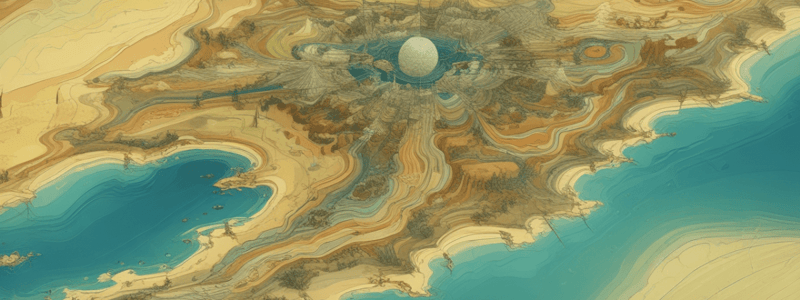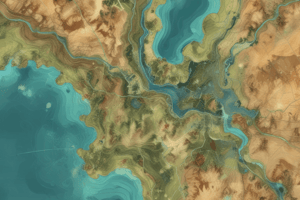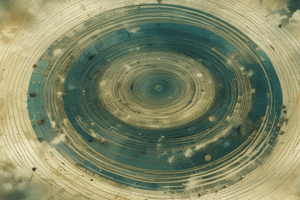Podcast
Questions and Answers
In areas with high ______, opposing look directions are often necessary to fill in areas of radar shadow.
In areas with high ______, opposing look directions are often necessary to fill in areas of radar shadow.
relief
The local ______ angle is defined as the angle between the radar line of sight to the line normal to the local slope.
The local ______ angle is defined as the angle between the radar line of sight to the line normal to the local slope.
incident
The local ______ angle can have a large effect on image brightness per pixel.
The local ______ angle can have a large effect on image brightness per pixel.
incident
The local ______ angle is the largest source of error in radiometric calibration.
The local ______ angle is the largest source of error in radiometric calibration.
Topographic displacement differs between radar and optical systems due to the different ______ geometries.
Topographic displacement differs between radar and optical systems due to the different ______ geometries.
Opposing look directions for agricultural fields may produce different tones on the image due to ______ direction related to planting.
Opposing look directions for agricultural fields may produce different tones on the image due to ______ direction related to planting.
On fixed-looking systems, two look directions can be acquired using ______ (east-looking) and descending (west-looking) passes.
On fixed-looking systems, two look directions can be acquired using ______ (east-looking) and descending (west-looking) passes.
Radar shadow can be filled in by using opposing look directions in areas of high ______.
Radar shadow can be filled in by using opposing look directions in areas of high ______.
Topographic/Relief Displacement is due to the different ______ geometries of radar and optical systems.
Topographic/Relief Displacement is due to the different ______ geometries of radar and optical systems.
Local incident angle effects can be seen in the brightness of the image per ______.
Local incident angle effects can be seen in the brightness of the image per ______.
Study Notes
Look Direction
- Opposing look directions can produce different tones on an image due to row direction related to planting, tilling, or harvesting in agricultural fields.
- In areas with high relief, opposing look directions are necessary to fill in areas of radar shadow.
- Fixed-looking systems like RADARSAT can acquire two look directions using ascending (east-looking) and descending (west-looking) passes.
Local Incident Angle
- Local incident angle (θloc) is defined as the angle between the radar line of sight and the line normal to the local slope.
- θi is the flat-earth or ellipsoid incident angle.
- Local incident angle has a large effect on image brightness per pixel.
- Local incident angle is the largest source of error in radiometric calibration.
Local Incident Angle Effects
- Effects of local incident angle include changes in image brightness per pixel.
- Local incident angle affects radiometric calibration.
Topographic/Relief Displacement
- Topographic displacement differs between radar and optical systems due to different imaging geometries.
- Shadowing in radar imagery is important for terrain relief interpretation.
- Radar shadow is a key indicator of terrain relief.
Radar Shadow
- Radar shadow occurs in areas on the ground surface not illuminated by the radar due to geometry and scene relief.
- Radar shadows appear very dark in tone on the imagery.
- Shadows occur in the down-range direction behind tall objects.
- Shadows are a good indicator of radar illumination direction if annotation is missing or incomplete.
- Shadowing becomes more prominent towards far-range due to increasing incident angle.
- Radar shadow can provide information about the scene, such as an object's height.
Foreshortening
- Foreshortening is the appearance of compression of features in the scene that are tilted towards the radar.
- It leads to a relatively brighter appearance of these slopes.
- Foreshortening is at a maximum when a steep slope is orthogonal to the radar beam.
- Effects of foreshortening are reduced with increasing incident angles.
- At the grazing angle, where incident angles approach 90°, foreshortening effects are eliminated, but severe shadowing may occur.
Resolution Cell
- Resolution cell is a function of range resolution (rR) and azimuth resolution (rA).
- Slant range (rR) and ground range (rGR) images have different scales.
- Differences between slant and ground range resolution are highest at small incident angles.
- rR and rGR converge at high incident angles (e.g., 70°).
Studying That Suits You
Use AI to generate personalized quizzes and flashcards to suit your learning preferences.
Related Documents
Description
Test your understanding of radar imagery interpretation with this quiz on shadowing and foreshortening. Learn how to analyze radar images to identify terrain relief features and understand the effects of shadowing and foreshortening on image interpretation.




